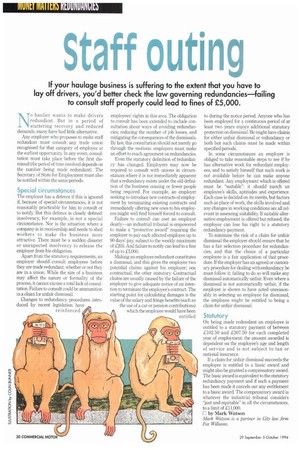Staff outing
Page 32

If you've noticed an error in this article please click here to report it so we can fix it.
If your haulage business is suffering to the extent that you have to lay off drivers, you'd better check the law governing redundancies—failing to consult staff properly could lead to fines of 0,000.
IN, o haulier wants to make drivers redundant. But in a period of stuttering recovery and reduced demands, many have had little alternative.
Any employer who proposes to make staff redundant must consult any trade union recognised for that category of employee at the earliest opportunity. In any event, consultation must take place before the first dismissal (the period of time involved depends on the number being made redundant). The Secretary of State for Employment must also be notified within the same periods.
Special circumstances The employer has a defence if this is ignored if, because of special circumstances, it is not reasonably practicable for him to consult or to notify. But this defence is closely defined: insolvency, for example, is not a special circumstance. Nor is the situation where a company is in receivership and needs to shed workers to make the business more attractive. There must be a sudden disaster or unexpected insolvency to release the employer from his obligation.
Apart from the statutory requirements, an employer should consult employees before they are made redundant, whether or not they are in a union. While the size of a business may affect the nature or formality of the process, it cannot excuse a total lack of consultation. Failure to consult could be ammunition in a claim for unfair dismissal.
Changes to redundancy procedures introduced by recent legislation have reinforced employees' rights in this area, The obligation to consult has been extended to include consultation about ways of avoiding redundancies, reducing the number of job losses, and mitigating the consequences of the dismissals. By law, this consultation should not merely go through the motions: employers must make an effort to reach agreement on redundancies.
Even the statutory definition of redundancy has changed. Employers may now be required to consult with unions in circumstances where it is not immediately apparent that a redundancy exists under the old definition of the business ceasing or fewer people being required. For example, an employer seeking to introduce new contracts of employment by terminating existing contracts and immediately offering new ones to his employees might well find himself forced to consult.
Failure to consult can cost an employer dearly—an industrial tribunal is empowered to make a "protective award" requiring the employer to pay each affected employee up to 90 days' pay, subject to the weekly maximum of £205. And failure to notify can lead to a fine of up to c£5,000.
Making an employee redundant constitutes a dismissal, and this gives the employee two potential claims against his employer; one contractual, the other statutory. Contractual claims are usually caused by the failure of the employer to give adequate notice of an intention to terminate the employee's contract. The starting point for calculating damages is the value of the salary and fringe benefits (such as the use of a car or pension contributions) which the employee would have been entitled
to during the notice period. Anyone who has been employed for a continuous period of at least two years enjoys additional statutory protection on dismissal. He might have claims for either unfair dismissal or redundancy or both but such claims must he made within specified periods.
In some circumstances an employer is obliged to take reasonable steps to see if he has alternative work for redundant employees, and to satisfy himself that such work is not available before he can make anyone redundant. Any employment which is offered must be "suitable": it should match an employee's skills, aptitudes and experience. Each case is decided on its merits, but factors such as place of work, the skills involved and any changes in working conditions are all relevant in assessing suitability. If suitable alternative employment is offered but refused, the employee can lose his right to a statutory redundancy payment.
To minimise the risk of a claim for unfair dismissal the employer should ensure that he has a fair selection procedure for redundancies, and that the choice of a particular employee is a fair application of that procedure. If the employer has an agreed or customary procedure for dealing with redundancy he must follow it; failing to do so will make any dismissal automatically unfair. Even where a dismissal is not automatically unfair, if the employer is shown to have acted unreasonably in selecting an employee for dismissal, the employee might be entitled to bring a claim for unfair dismissal.
Statutory On being made redundant an employee is entitled to a statutory payment of between £102.50 and £307.50 for each completed year of employment: the amount awarded is dependent on the employee's age and length of service and is not subject to tax or national insurance.
If a claim for unfair dismissal succeeds the employee is entitled to a basic award and might also be granted a compensatory award. The basic award is equivalent to the statutory redundancy payment and if such a payment has been made it cancels out any entitlement to a basic award. The compensatory award is whatever the industrial tribunal considers "just and equitable" in all the circumstances, to a limit of Z11,000.
E by Mark Watson Mark Watson is a partner in City law .firm Fox Williams.




























































































